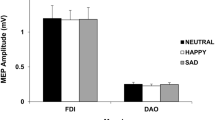Abstract
EMG responses were recorded from lower facial muscles (depressor labii inferioris or depressor anguli oris) of 12 normal subjects after magnetic stimulation of the motor cortex. Using a figure-of-eight stimulating coil, the largest responses were obtained from points around 8–10 cm lateral to the vertex. Usually they were bilateral and had the same latency (11–12 ms) on both sides of the face. Patients with complete Bell's palsy had no response in muscles on the same side as the lesion, indicating that the ipsilateral component to cortical stimulation was not the result of recrossing in the periphery of nerve fibres from the contralateral side. Single-unit studies showed that cortical stimulation produced two phases of motoneuronal facilitation: a short-latency (central motor delay from contralateral cortex to the intracranial portion of the facial nerve, 7.6 ms), short-duration (1– to 2-ms duration peak in the post-stimulus time histogram) input, which was more commonly evoked by contralateral than ipsilateral stimulation; and a longer latency (central delay > 15 ms), long-duration input evoked equally well from either hemisphere. The former may represent activity in a predominantly contralateral oligosynaptic corticobulbar pathway; the latter, a polysynaptic indirect (e.g. co-rticotegmento-nuclear) bilateral pathway to lower facial muscles.
Similar content being viewed by others
References
Barnes S (1901) Degenerations in hemiplegia: with special reference to a ventrolateral pyramidal tract, the accessory fillet and Pick's bundle. Brain 24:463–501
Benecke R, Meyer B-U, Schönle P, Conrad B (1988) Transcranial magnetic stimulation of the human brain: responses in muscles supplied by cranial nerves. Exp Brain Res 71:623–632
Braus H (1954) Anatomie des Menschen. Springer, Berlin Heidelberg New York, pp 722–747
Brodal A (1969) Neurological anatomy in relation to clinical medicine. Oxford University Press, London, pp 397–411
Cruccu G, Berardelli A, Inghilleri M, Manfredi M (1990) Corticobulbar projections to upper and lower facial motoneurons. A study by magnetic transcranial stimulation in man. Neurosci Lett 117:68–73
Day BL, Dressler D, Maertens de Noordhout A, Marsden CD, Nakashima K, Rothwell JC, Thompson PD (1989) Electric and magnetic stimulation of the human motor cortex: surface and single motor unit responses. J Physiol (Lond) 412:449–473
Gambi D, Tonalli (1973) Contralateral facial nerve reinnervation. In Desmedt JE (ed) New developments in electromyography and clinical neurophysiology, vol 2. Karger, Basel, pp 338–343
Hoche A (1898) Beiträge zur Anatomie der Pyramidenbahn und der oberen Schleife, nebst Bemerkungen über die abnormen Bündel in Pons und Medulla oblongata. Arch Psychiatr Nervenkr 30:103–135
Iwatsubo T, Kuzuhara S, Kanemitsu A, Shimada H, Toyokura Y (1990) Corticofugal projections to the motor nuclei of the brainstem and spinal cord in humans. Neurology 40:309–312
Jenny AB, Saper CB (1987) Organization of the facial nucleus and corticofacial projection in the monkey: a reconsideration of the upper motor neuron facial palsy. Neurology 37:930–939
Kuypers HGJM (1958a) Corticobulbar connections to the pons and lower brainstem in man. Brain 81:364–388
Kuypers HGJM (1958b) Some projections from the pericentral cortex to the pons and lower brainstem in monkey and chimpanzee. J Comp Neurol 110:221–251
Meyer B-U, Britton TC, Benecke R (1989) Investigation of unilateral facial weakness: magnetic stimulation of the proximal facial nerve and of the face-associated motor cortex. J Neurol 236:102–107
Meyer B-U, Fauth C, Liscic R, Bischoff C, Conrad B (1992) Organisation of descending motor tracts to motoneurones of lower facial muscles, neck muscles, tongue muscles, and proximal and distal arm muscles in man. An analysis of motor responses elicited by transcranial magnetic stimulation (abstract). Mov Disord [Suppl] 7:19
Meyer B-U, Werhahan K, Rothwell JC, Roericht S (1994) Functional organisation of corticonuclear pathways to motoneurones supplying lower facial muscles in man (abstract). J Physiol (Lond) 476:30p
Patrineili JR, Anderson RL (1988) Anatomy of the orbicularis oculi and other facial muscles. Ad v Neurol 49:15–23
Trontelj MA, Trontelj JV (1978) Reflex arc of the first component of the human blink reflex: a single motoneurone study. J Neurol Neurosurg Psychiatr 41:538–547
Walker AE, Green HD (1938) Electrical excitability of the motor face area: a comparative study in primates. J Neurophysiol 1:152–165
Weidenhammer W (1896) Zur Frage der absteigenden Degeneration der medialen Schleife. Neurol Zb 15:191–192
Author information
Authors and Affiliations
Rights and permissions
About this article
Cite this article
Meyer, BU., Werhahn, K., Rothwell, J.C. et al. Functional organisation of corticonuclear pathways to motoneurones of lower facial muscles in man. Exp Brain Res 101, 465–472 (1994). https://doi.org/10.1007/BF00227339
Received:
Accepted:
Issue Date:
DOI: https://doi.org/10.1007/BF00227339




